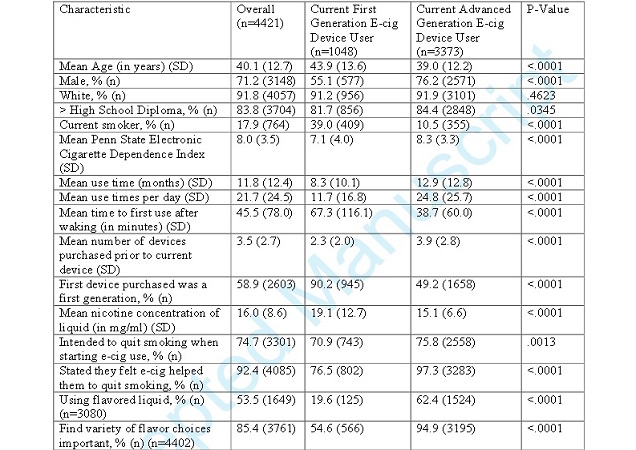
A new study looking at the factors associated with switching from cigalike e-cigarettes to advanced devices has provided more evidence that newer-generation devices are more effective when it comes to quitting smoking, and confirms what most vapers know: advanced devices are just better all round. Although much of the focus was on the reasons for upgrading to advanced devices, the group using advanced devices was over three and a half times less likely to be smoking conventional cigarettes than those vaping cigalikes.
However, with regulations as currently proposed, many manufacturers of advanced-level devices would be put out of business thanks to excessive bureaucratic requirements, leaving primarily cigalikes – particularly those with the financial backing of tobacco companies – available for smokers trying to reduce their harm. In short, the study offers more reason to believe that such regulation would lead to less people quitting smoking and more preventable deaths.
What They Did – Surveying Vapers About Their Choice of Device
The basic aim of the study was to find out more about the factors influencing choice of device. Vapers – who’d all used an e-cig for at least 30 days – were recruited from websites including WebMD and the E-Cigarette Forum, with the final sample consisting of 4,421 participants. The survey ran from December 2012 to August 2014, and included questions about devices currently and previously used, flavors, nicotine levels, reasons for changing devices, current smoking status and participants’ level of dependence on e-cigarettes. The classification used for e-cigs was fairly simplistic, though, with “advanced” device meaning “button-operated and bigger than a cigarette,” encompassing both eGo-style devices and mods.
What They Found – More Later-Gen E-Cig Users Have Quit than Cigalike Users

The results show that around 59 percent started out with a cigalike device, with the remainder starting on more advanced systems. From those who started on a cigalike, 63.7 percent later transitioned to a more advanced, later generation device, but for the ones who started out with a better device – surprise, surprise – hardly any (just 5.7 percent) transitioned to cigalikes further down the line.
The full results (available in the paywalled paper) show that the users of advanced devices are more addicted on average (based on scores on the Penn State Electronic Cigarette Dependence Index) than cigalike users, despite using slightly lower nicotine levels on average. Advanced device users vaped sooner after waking (39 vs. 67 minutes), vaped over twice as often per day, and had generally been vaping for longer (13 months vs. 8 months).
Of the entire sample, around 18 percent were current smokers, but users of cigalike devices were much more likely to be smokers: just 10.5 percent of advanced device users still smoked, in comparison to 39 percent of cigalike users. Users of both types of device intended to quit smoking by vaping (71 percent of cigalike users and 76 percent of advanced device users), but advanced device users were much more likely to say their e-cig helped them quit (97.3 percent of advanced device users vs. 76.5 percent of cigalike users). The newer-generation device users had also ordinarily tried more models prior to their current one – around four in comparison to two for cigalike users.
All of this is very suggestive of the benefits of advanced devices in comparison to cigalikes. Despite similar numbers of users intending to quit, advanced device users were much more likely to have done so, and they generally vaped more often and were more dependent. In short, the newer-gen device users seem to have been more successful at transferring their addiction to e-cigarettes.
With this in mind, the other results become more illuminating. The advanced device users were much more likely to vape (non-tobacco) flavored liquid (62.4 percent compared to 19.6 percent), and were more likely to say flavors are important, with 95 percent of advanced device users saying so compared to 54.6 percent of cigalike users. This is in agreement with previous research, and adds more weight to the idea that flavors are very important to the success of e-cigarettes – likely because they help to differentiate the habit from smoking and make it more enjoyable.
More advanced device users said they switched to their current device to get a more satisfying “hit” (77 percent vs. 58.6 percent of the cigalike users), and although the majority of both groups said battery life was important, the advanced device users were more unanimous in their preference. The biggest difference in what the groups found important was the similarity in appearance to a cigarette, with 84 percent of the cigalike group saying it’s important compared to just 8.7 percent of the advanced device group.
Are Advanced E-Cigarettes More Effective for Helping Smokers Quit?

While the study’s main aim – working out what drives the switch to better devices – is of limited interest to vapers (since we already know), the other findings do offer more evidence on a very important issue: the relative effectiveness of cigalike vs. “advanced devices” (meaning: not cigalikes) for quitting. The findings should be interpreted cautiously, since the study was of dedicated users recruited in part from places like the E-Cigarette Forum, and therefore quit-rates would be expected to be much higher than for ordinary users. However, the difference in quit-rates within this group between those who still vape cigalikes and the newer-gen device users provides even further reason to think more advanced devices are better for helping smokers quit. This has also been suggested by other studies, so the case is growing stronger and stronger – if true, the clinical trial finding that e-cigs are about as good for quitting as patches is probably a substantial underestimate.
One of the main reasons for this is likely to be nicotine delivery, for which advanced devices are much better than cigalikes. By providing a faster and more substantial hit of nicotine, advanced devices are better at satisfying smokers’ addictions, and therefore would be expected to boost quit-rates. Additionally, advanced devices open up a much wider range of flavors and provide more substantial battery life, making them more enjoyable to vape with all-round. Obviously, there is a reason that almost 95 percent of those who started on advanced systems never transitioned to cigalikes.
One potential issue, though, is that the advanced device users had tried more devices and had been vaping longer on average. This gave them more experience with vaping and more time to actually quit smoking. However, the difference in quit-rates was quite substantial, so this probably wouldn’t explain the differences entirely. It would be interesting to know whether the majority of advanced device users came from places like the E-Cigarette Forum and the cigalike users were more likely to be from places like WebMD, since this could also be a factor, and definitely seems plausible.
Conclusion – More Reason to Support Later-Generation E-Cigarettes
Despite the growing concern about the effects of higher power on unwanted chemical production (like the formaldehyde scare), and the likelihood that the FDA’s proposed regulations would impact higher-end devices much more than cigalikes, it seems that bigger devices offer the greatest potential benefit to smokers. Instead of demonizing later-generation, open-system devices and crushing them under regulations, the evidence suggests that – if helping smokers quit and preventing needless deaths is your goal – they should be protected and encouraged to proliferate as much as possible.

